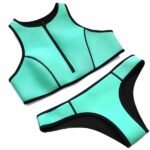Have you ever found yourself torn between choosing a wetsuit or a swimsuit for your next water adventure? The decision can significantly impact your comfort and performance in the water. Understanding the differences between these two types of swimwear is essential to make an informed choice that best suits your needs.
Wetsuits and swimsuits serve distinct purposes, each designed to enhance your experience in the water through unique features and functionalities.
I remember the first time I donned a wetsuit for a chilly morning surf session. The immediate warmth and protection it provided were unparalleled compared to my usual swimsuit. This experience made me curious about how these garments differ and why each is suited for specific activities.
Let’s explore the comprehensive differences between wetsuits and swimsuits to help you choose the right gear for your water activities.
What Are Wetsuits and Swimsuits?
Wetsuits and swimsuits are both types of swimwear, but they are designed for different purposes and environments. A wetsuit is made from neoprene[^1], a synthetic rubber, and is primarily used to provide thermal insulation and protection in cold water. On the other hand, a swimsuit is typically made from lightweight, quick-drying fabrics like Lycra or polyester, designed for comfort and flexibility in warmer water.
Wetsuits are designed to keep you warm and protect against elements, while swimsuits prioritize comfort and ease of movement in warmer conditions.
During summer beach outings, my swimsuit offers unmatched comfort and freedom, perfect for long swims and sunbathing. In contrast, my wetsuit becomes indispensable during winter surf trips, keeping me warm and safe in colder waters.
Dive Deeper: Materials and Construction
Neoprene in Wetsuits
Neoprene is a key component of wetsuits, providing both insulation and buoyancy. The thickness of neoprene can vary, typically ranging from 2mm to 7mm, depending on the water temperature and the level of insulation required. Thicker neoprene offers more warmth but can restrict movement, while thinner neoprene provides greater flexibility with less insulation.
Fabrics in Swimsuits
Swimsuits are crafted from fabrics like Lycra[^2], polyester, or nylon, which are chosen for their lightweight, stretchy, and quick-drying properties. These materials allow for maximum flexibility and comfort, making swimsuits ideal for activities like competitive swimming, recreational swimming, and water aerobics.
| Feature | Wetsuits | Swimsuits |
|---|---|---|
| Material | Neoprene | Lycra, Polyester, Nylon |
| Purpose | Thermal insulation, protection | Comfort, flexibility |
| Thickness | 2mm to 7mm | Thin and lightweight |
| Flexibility | Moderate to low depending on thickness | High |
| Use Cases | Cold water sports, diving, surfing | Warm water swimming, recreational use |
Understanding the materials and construction of each type of swimwear helps in selecting the right gear for your specific water activities.
Can You Wear a Wetsuit Just to Swim?
Yes, you can wear a wetsuit just to swim, but it depends on the water temperature and your personal comfort. Wetsuits provide buoyancy and insulation, which can enhance your swimming performance in colder waters. However, in warmer climates, wearing a wetsuit might lead to overheating and discomfort.
Wearing a wetsuit for swimming can be beneficial in cold water by providing warmth and buoyancy, but it may be unnecessary and uncomfortable in warm conditions.
I once decided to wear my wetsuit during a summer swim in surprisingly chilly waters. While it kept me warm, I quickly felt restricted and overheated, which made the swim less enjoyable than usual.
Dive Deeper: Benefits and Drawbacks
Benefits of Wearing a Wetsuit for Swimming
- Thermal Protection: Keeps your body warm in cold water, preventing hypothermia.
- Buoyancy: Adds buoyancy, which can help reduce fatigue and improve swim efficiency.
- Protection: Shields your skin from sunburn, jellyfish stings, and abrasions.
Drawbacks of Wearing a Wetsuit for Swimming
- Overheating: In warm water, a wetsuit can cause excessive heat retention, leading to discomfort.
- Reduced Flexibility: The stiffness of neoprene can restrict natural movement, hindering swimming performance.
- Increased Drag: Wetsuits can create additional drag, making swimming more strenuous.
| Aspect | Benefits | Drawbacks |
|---|---|---|
| Thermal | Keeps warm in cold water | Overheating in warm conditions |
| Buoyancy | Reduces fatigue, aids in swimming | May add unwanted buoyancy |
| Protection | Shields from environmental hazards | Can restrict movement |
| Performance | Enhances endurance in cold conditions | Increased drag can hinder speed |
Balancing these benefits and drawbacks is crucial when deciding whether to wear a wetsuit for swimming.
What Are the Key Differences Between Wetsuits and Swimsuits?
The primary differences between wetsuits and swimsuits lie in their material, purpose, insulation, and design. Wetsuits are made from neoprene for insulation and protection in cold water, while swimsuits are crafted from lightweight, flexible fabrics for comfort and performance in warmer conditions.
Key differences include material composition, thermal insulation, flexibility, and intended use, making each suited for specific water environments and activities.
Dive Deeper: Detailed Comparison
Material Composition
Wetsuits are constructed from neoprene, which is a closed-cell synthetic rubber. This material provides excellent thermal insulation and resistance to water. Swimsuits, however, use fabrics like Lycra or polyester, which offer high flexibility and quick-drying properties without significant insulation.
Thermal Insulation
The insulation provided by neoprene in wetsuits is designed to keep the body warm in cold water by trapping a layer of water between the suit and the skin, which is then warmed by body heat. Swimsuits lack this insulation, making them ideal for warmer waters where overheating is a concern.
Flexibility and Fit
While wetsuits offer some flexibility, they are generally bulkier and can restrict movement compared to swimsuits. Swimsuits are designed to hug the body closely, allowing for maximum range of motion and speed, which is essential for competitive swimming and other performance-based water activities.
| Feature | Wetsuits | Swimsuits |
|---|---|---|
| Material | Neoprene | Lycra, Polyester, Nylon |
| Insulation | High, retains body heat in cold water | Low, no thermal insulation |
| Flexibility | Moderate, can be restrictive | High, allows full range of motion |
| Design | Thick, bulky, sometimes with reinforced seams | Thin, sleek, form-fitting |
| Intended Use | Cold water sports, diving, surfing | Warm water swimming, recreational use |
| Protection | Protects against cold, UV, abrasions | Minimal protection, focused on comfort |
Understanding these differences helps in selecting the appropriate swimwear based on the water temperature and the nature of the water activity.
Which One Is Best for Water Activities?
Choosing between a wetsuit and a swimsuit largely depends on the water temperature, the activity you’re engaging in, and the level of protection you need. Wetsuits are essential for activities in cold waters, providing warmth, buoyancy, and protection, while swimsuits excel in warmer water environments by offering comfort and flexibility.
In cold-water activities, a wetsuit will enhance your experience by keeping you warm, while a swimsuit is the best option for warm-water swimming, allowing you to move freely.
I always choose a wetsuit when heading out for a winter surf session, but when swimming in the warm ocean, my swimsuit provides all the flexibility I need without the added bulk.
How Do Wetsuits and Swimsuits Impact Comfort and Performance?
The comfort and performance of your swimwear are directly influenced by the type of material, fit, and design. Wetsuits provide insulation and buoyancy, which can improve performance in cold waters but may feel bulky or restrictive in warmer environments. Swimsuits, on the other hand, are designed for maximum flexibility and comfort but offer no thermal protection.
Choosing the right swimwear based on water temperature and your performance goals can make a significant difference in your comfort and ability to perform well in the water.
Performance Tip: Always choose a wetsuit or swimsuit based on the activity and water conditions for the best comfort and performance.
Conclusion
In conclusion, whether you choose a wetsuit or a swimsuit depends on your activity, the water temperature, and your personal preferences. Wetsuits provide the necessary protection and insulation for cold-water activities, while swimsuits are ideal for warm-water swimming.
By understanding the differences, you can make an informed decision that ensures maximum comfort, safety, and performance in the water.











